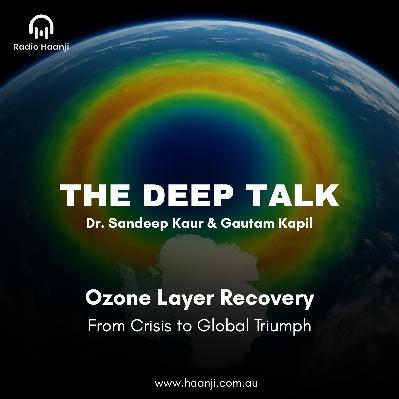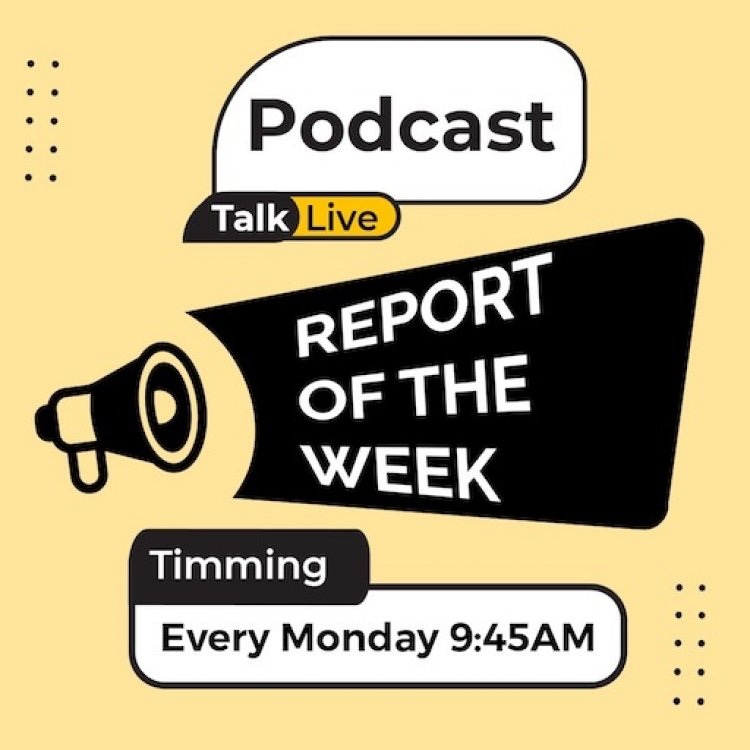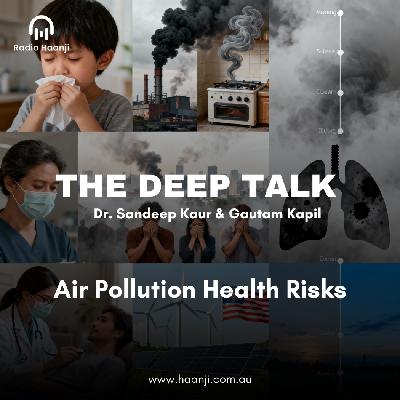Ozone Layer Recovery: From Crisis to Global Triumph - The Deep Talk
Description
Imagine peering into the frozen expanse of Antarctica in the spring of 1985, only to find a gaping void in Earth's protective shield—a "hole" in the ozone layer large enough to swallow entire continents. This wasn't science fiction; it was a stark warning from our planet, triggered by everyday chemicals we'd unleashed into the sky. Today, that crisis stands as a beacon of hope: through bold science, united politics, and relentless public outcry, we've set the ozone layer on a path to full recovery by mid-century. As an environmental historian with over a decade tracking planetary health metrics, I've witnessed how this story isn't just history—it's a blueprint for tackling today's wildfires, melting ice caps, and rising seas. In this deep dive, we'll trace the ozone's dramatic arc, from brink-of-collapse peril to steady healing, and unpack the timeless lessons it holds for our warming world.
What Is the Ozone Layer and Why Does It Matter?
Nestled about 10 to 30 miles above our heads in the stratosphere sits the ozone layer—a thin veil of O3 molecules that acts as Earth's sunscreen. It absorbs up to 99% of the sun's harmful ultraviolet (UV) rays, shielding us from skin cancers, cataracts, and ecosystem collapse. Without it, life as we know it would wither: phytoplankton in oceans would die off, disrupting food chains, while crops like soybeans could lose 20-30% of yields under intensified UV exposure.
This fragile barrier isn't invincible. By the 1970s, scientists like Sherwood Rowland and Mario Molina warned that chlorofluorocarbons (CFCs)—ubiquitous in aerosols, refrigerators, and foams—were drifting upward, breaking apart ozone molecules in a catalytic frenzy. One CFC molecule can dismantle 100,000 ozone atoms before fading away. Fast-forward to today: the ozone layer's recovery journey reminds us that what we release today echoes for decades, but collective action can rewrite the ending.
The Shocking Discovery: Uncovering the Antarctic Ozone Hole
In the chill of Antarctic spring, British Antarctic Survey scientists Joe Farman, Brian Gardiner, and Jonathan Shanklin pored over decades of data from Halley Station. What they found in 1985 floored the world: ozone levels had plummeted 40% below normal, carving a seasonal "hole" over the South Pole spanning 12 million square miles—three times the size of the U.S. This wasn't gradual erosion; it was a vortex of destruction, fueled by unique polar conditions like frigid stratospheric clouds that amplified chemical reactions.
The revelation hit like a thunderclap. Satellite images from NASA's Total Ozone Mapping Spectrometer confirmed it: a swirling deficit where ozone should thrive. Public headlines screamed "Ozone Alert!" sparking fear of a UV-bathed future. Yet, this shock ignited urgency. Governments, once skeptical, now faced undeniable proof that human ingenuity had backfired spectacularly.
Why did the hole form over Antarctica specifically? Harsh winters isolated cold air, creating a brew perfect for ozone assassins. This discovery wasn't just data—it was a call to arms, proving environmental threats know no borders.
What Caused the Ozone Hole? Human Activity's Hidden Threat
Picture this: in the innocent glow of post-WWII prosperity, CFCs emerged as miracle chemicals—non-toxic, non-flammable wonders for everything from hairspray to car ACs. By the 1970s, annual production topped 1 million tons, wafting into the stratosphere where UV light cleaved them into chlorine radicals. Each chlorine atom then triggered a chain reaction, devouring ozone like a molecular Pac-Man.
But it wasn't just CFCs; halons from fire extinguishers and methyl bromide from pesticides piled on. Over Antarctica, polar stratospheric clouds (PSCs) in winter's deep freeze activated these culprits, turning the hole into an annual ritual by the 1980s. UV spikes below threatened marine life—krill populations could halve—and human health, with skin cancer rates projected to surge 10% per 1% ozone loss.
The science was clear: this was anthropogenic Armageddon, not natural whim. Yet, industry lobbied hard, dubbing warnings "alarmist." The hole's unveiling shattered that denial, showing how unchecked innovation can scar the sky.
Quick Fact List: Culprits Behind the Ozone Hole
- CFCs: From refrigerants and foams; peaked at 1.2 billion tons emitted by 1990s.
- Halons: Fire suppressants; 10x more potent than CFCs per molecule.
- Bromine Compounds: Pesticides; amplify destruction in cold polar air.
- Natural Factors: Volcanic eruptions like 2022's Hunga Tonga temporarily worsened it, but humans set the stage.
The Montreal Protocol: How Global Cooperation Saved the Day
Facing the ozone abyss, world leaders didn't dither—they drafted. In 1987, 24 nations in Montreal inked the Montreal Protocol, freezing CFC production at 1986 levels and mandating a 50% cut by 1998. Ratified by all 198 UN countries by 2008, it was diplomacy on steroids: amendments in London (1990) and Copenhagen (1992) accelerated phaseouts, slashing ODS (ozone-depleting substances) by 99% globally.
Science drove it—NASA expeditions like NOZE in 1986 delivered the "smoking gun": chlorine monoxide spikes correlating with ozone dips. Politics followed: U.S. Senator Al Gore rallied Congress, while public campaigns like Australia's "Slip! Slop! Slap!" urged sun safety amid rising UV fears. Industry pivoted too, birthing HFCs as CFC alternatives (though later regulated for warming potential).
This wasn't flawless—illegal CFC smuggling peaked in the 1990s—but compliance hit 98% by 2020. The Protocol's genius? It blended enforcement with tech transfer, aiding developing nations via the Multilateral Fund. Result: a treaty that averted 135 billion tons of CO2-equivalent emissions, cooling the planet by 0.5°C.
Milestones in a Nutshell:
- 1985 Vienna Convention: Framework for action.
- 1987 Montreal Signing: Initial phaseout blueprint.
- 1990 London Amendments: Halon bans.
- 2016 Kigali Amendment: HFC curbs for climate synergy.
Ready to channel this energy? Explore sustainable living tips to make your mark today.
Signs of Healing: Ozone Layer Recovery Progress in 2025
Fast-forward to October 2025: the ozone hole's 2024 peak shrank to the seventh-smallest since 1992, clocking in at under 10 million square miles—a 20% drop from 2006's monster. NASA's Ozone Watch and NOAA's monitoring confirm: upper stratospheric ozone is rebounding 1-3% per decade, thanks to ODS levels dipping below 1990s peaks.
Yet, it's no straight shot. 2023's unusually large hole (blamed on Southern Hemisphere winds) and wildfire smoke injections remind us variability lingers. Projections? Full Arctic recovery by 2045, global by 2040, Antarctic by 2066—if policies hold. WMO's 2025 bulletin hails it as "driven by science," with UV exposure down 20% in healed zones, sparing millions from cancer.
This healing underscores the Protocol's ROI: $2.2 trillion in health savings by 2030, per UNEP.
Recovery Milestone
Projected Date
Key Metric
Global Ozone
2040
Back to 1980 levels
Arctic Ozone
2045
Minimal seasonal dips
Antarctic Hole
2066
<5 million sq mi peak
Lessons from Ozone Recovery for Today's Climate Challenges
The ozone saga whispers (or shouts) profound truths for our climate quagmire. First: science must lead. Rowland and Molina's 1974 Nobel-winning warnings, ignored at first, eventually pierced boardrooms—echoing today's IPCC pleas on net-zero.
Second: unity trumps isolation. The Protocol's universal buy-in, including China and India's tech aid, dodged the North-South rifts stalling Paris Agreement progress. Public pressure? Vital—1980s boycotts of CFC sprays mirrored divestment from fossil fuels now.
Third: co-benefits abound. Phasing out ODS cooled the globe, proving environmental wins compound. For 2025's floods and droughts, imagine taxing plastics to fund renewables—mirroring Montreal's fund.
But pitfalls lurk: HFC leaks now warm like CO2, demanding Kigali's full enforcement. The lesson? Act swift, adapt often. As MIT's 2025 study affirms, ozone's mend buys us time—but only if we heed the blueprint.
Actionable Insights for You:
- Advocate Locally: Push for green refrigerants in your city.
- Educate Peers: Share ozone facts to build climate literacy.
- Vote Green: Support policies echoing Montreal's resolve.
What environmental win inspires you most? Drop a comment below—we'd love to hear and feature reader stories!
Key Takeaways: Hope in Action
- The 1985 ozone hole discovery exposed human-driven depletion, but the Montreal Protocol phased out 99% of ODS, sparking recovery.
- In 2025, the hole is shrinking, with full healing eyed for 2040-2066—averting UV disasters and cooling Earth by 0.5°C.
- Core Lesson: Science + politics + people = planetary progress. Apply it to climate action now for a resilient tomorrow.
Inspired? Subscribe to our newsletter for weekly eco-updates and exclusive lead magnet: "10 Ways to Green Your Daily Routine" PDF.
Frequently Asked Questions
What is the ozone layer, and how does it protect Earth?
The ozone layer is a stratospheric band of O3 that blocks 97-99% of UV-B rays, preventing DNA damage in cells. Without it, skin cancers could double globally.
When was the Antarctic ozone hole discovered?
In 1985, by British scientists at Halley Station, revealing a 40% ozone drop—larger than models predicted, linking it to CFCs.
How did the Montreal Protocol contribute to ozone recovery?
Signed in 1987, it mandated ODS phaseouts, achieving 99% cuts by 2020. Amendments like Kigali (2016) added climate safeguards.
Is the ozone layer fully recovered in 2025?
Not yet—Antarctic recovery lags to 20






















